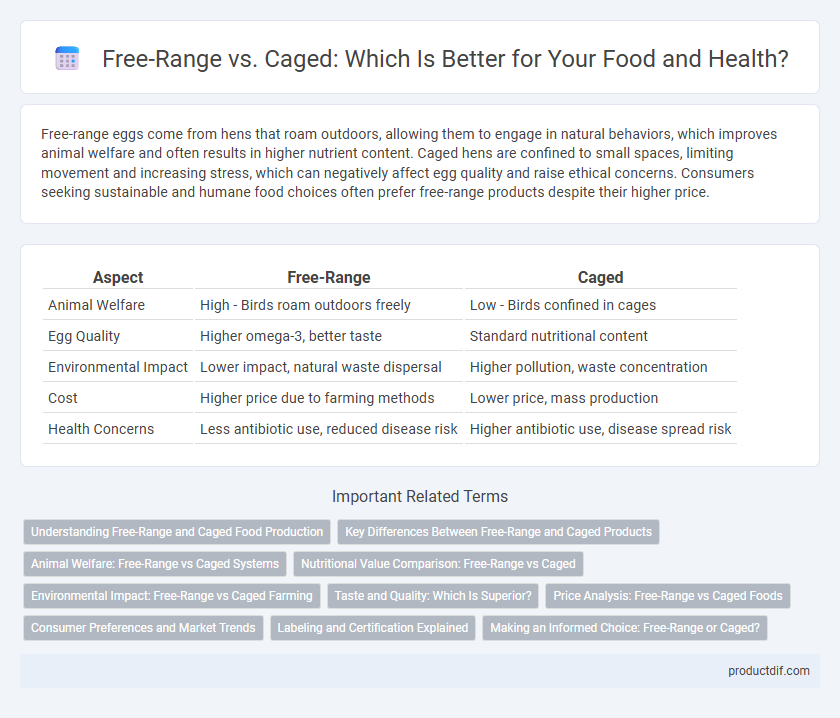Free-range eggs come from hens that roam outdoors, allowing them to engage in natural behaviors, which improves animal welfare and often results in higher nutrient content. Caged hens are confined to small spaces, limiting movement and increasing stress, which can negatively affect egg quality and raise ethical concerns. Consumers seeking sustainable and humane food choices often prefer free-range products despite their higher price.
Table of Comparison
| Aspect | Free-Range | Caged |
|---|---|---|
| Animal Welfare | High - Birds roam outdoors freely | Low - Birds confined in cages |
| Egg Quality | Higher omega-3, better taste | Standard nutritional content |
| Environmental Impact | Lower impact, natural waste dispersal | Higher pollution, waste concentration |
| Cost | Higher price due to farming methods | Lower price, mass production |
| Health Concerns | Less antibiotic use, reduced disease risk | Higher antibiotic use, disease spread risk |
Understanding Free-Range and Caged Food Production
Free-range food production involves raising animals with access to outdoor areas, allowing natural behaviors and improved welfare, which often leads to better nutritional profiles such as higher omega-3 fatty acids in eggs and meat. In contrast, caged production confines animals in restricted spaces, prioritizing efficiency and cost-effectiveness but often resulting in lower animal welfare and potential nutritional compromises. Understanding the differences between free-range and caged systems helps consumers make informed choices based on ethical considerations and health benefits.
Key Differences Between Free-Range and Caged Products
Free-range products come from animals raised with outdoor access, promoting natural behaviors and better animal welfare, while caged products originate from animals confined in restricted spaces with limited movement. Free-range foods often have higher nutritional value, including increased omega-3 fatty acids and vitamins, compared to caged counterparts. Consumers prioritize free-range options for ethical considerations, superior taste, and perceived health benefits.
Animal Welfare: Free-Range vs Caged Systems
Free-range systems enhance animal welfare by allowing chickens to roam outdoors, exhibit natural behaviors, and reduce stress compared to caged environments. Caged systems often restrict movement, leading to increased health issues such as osteoporosis and feather pecking due to confinement and lack of stimulation. Improved welfare in free-range systems correlates with lower mortality rates and better overall physical condition in poultry.
Nutritional Value Comparison: Free-Range vs Caged
Free-range eggs typically contain higher levels of omega-3 fatty acids, vitamin D, and antioxidants compared to caged eggs due to the hens' varied diet and exposure to sunlight. Studies show that free-range meat often has lower saturated fat and higher beneficial nutrients like vitamin E and iron. The superior nutritional profile of free-range products contributes to better overall health benefits than those from caged systems.
Environmental Impact: Free-Range vs Caged Farming
Free-range farming significantly reduces environmental impact by promoting natural grazing, which enhances soil health and biodiversity compared to caged farming that often leads to concentrated waste and soil degradation. The free-range system lowers greenhouse gas emissions by enabling better carbon sequestration in pasture lands, while caged farming relies heavily on energy-intensive feed production and waste management. Sustainable free-range practices contribute to ecosystem balance, whereas caged farming intensifies pollution and resource depletion.
Taste and Quality: Which Is Superior?
Free-range eggs and meat often exhibit richer flavors and superior texture compared to caged alternatives due to animals' varied diet and increased exercise. Studies indicate that free-range poultry contains higher levels of omega-3 fatty acids and antioxidants, enhancing nutritional quality and taste profile. Consumer preference trends consistently favor free-range products for their perceived freshness and complexity in flavor.
Price Analysis: Free-Range vs Caged Foods
Free-range foods typically command higher prices compared to caged alternatives due to increased production costs such as land, feed, and labor. Price analysis reveals that consumers pay a premium for free-range products, with eggs and poultry often priced 20-50% above caged counterparts. Market trends indicate growing demand for ethically sourced options, sustaining higher price points despite broader affordability concerns.
Consumer Preferences and Market Trends
Consumers increasingly prefer free-range eggs and poultry due to perceived health benefits, animal welfare concerns, and higher nutritional value, driving significant market growth in this sector. Market data shows a rising demand for free-range products, with sales outpacing caged alternatives as more retailers and foodservice providers shift to sourcing ethically raised poultry. Consumer surveys indicate willingness to pay premium prices for free-range options, highlighting a trend toward transparent supply chains and sustainable farming practices.
Labeling and Certification Explained
Free-range eggs are typically labeled with certifications from organizations such as the Certified Humane or Animal Welfare Approved, ensuring hens have outdoor access and better living conditions. Caged eggs often lack these independent certifications, reflecting restricted movement and higher stocking densities. Understanding labeling standards helps consumers make informed choices about animal welfare and product quality.
Making an Informed Choice: Free-Range or Caged?
Choosing between free-range and caged eggs impacts animal welfare, nutritional quality, and environmental sustainability. Free-range systems typically offer hens access to outdoor space, resulting in eggs with higher levels of omega-3 fatty acids and vitamins, while caged systems maximize production efficiency but restrict natural behaviors. Evaluating factors such as ethical considerations, nutrient content, and carbon footprint empowers consumers to make an informed choice aligning with personal values and health goals.
free-range vs caged Infographic

 productdif.com
productdif.com